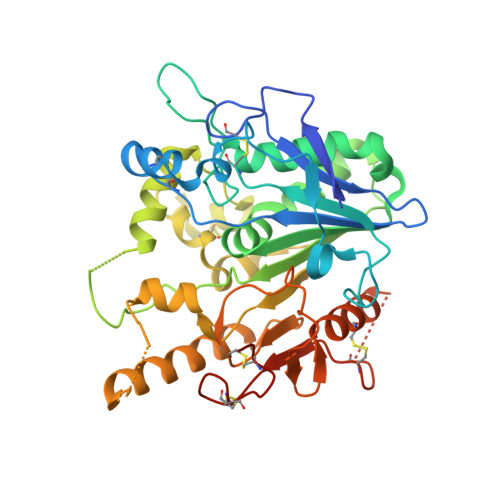Structural characterization of melatonin as an inhibitor of the Wnt deacylase Notum.
Zhao, Y., Ren, J., Hillier, J., Jones, M., Lu, W., Jones, E.Y.(2020) J Pineal Res 68: e12630-e12630
- PubMed: 31876313
- DOI: https://doi.org/10.1111/jpi.12630
- Primary Citation of Related Structures:
6TR5, 6TR6, 6TR7 - PubMed Abstract:
The hormone melatonin, secreted from the pineal gland, mediates multiple physiological effects including modulation of Wnt/¦Â-catenin signalling. The Wnt palmitoleate lipid modification is essential for its signalling activity, while the carboxylesterase Notum can remove the lipid from Wnt and inactivate it. Notum enzyme inhibition can therefore upregulate Wnt signalling. While searching for Notum inhibitors by crystallographic fragment screening, a hit compound N-[2-(5-fluoro-1H-indol-3-yl)ethyl]acetamide that is structurally similar to melatonin came to our attention. We then soaked melatonin and its precursor N-acetylserotonin into Notum crystals and obtained high-resolution structures (¡Ü1.5??) of their complexes. In each of the structures, two compound molecules bind with Notum: one at the enzyme's catalytic pocket, overlapping the space occupied by the acyl tail of the Wnt palmitoleate lipid, and the other at the edge of the pocket opposite the substrate entrance. Although the inhibitory activity of melatonin shown by in vitro enzyme assays is low (IC 50 75??mol/L), the structural information reported here provides a basis for the design of potent and brain accessible drugs for neurodegenerative diseases such as Alzheimer's disease, in which upregulation of Wnt signalling may be beneficial.
Organizational Affiliation:
Division of Structural Biology, Wellcome Centre for Human Genetics, University of Oxford, Oxford, UK.


















